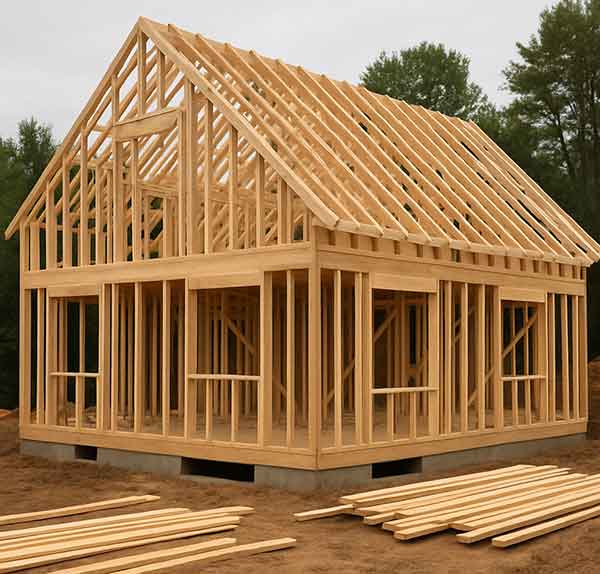
The landscape of residential construction is evolving rapidly, with an increasing number of homeowners and DIY enthusiasts turning toward home kits as a practical and cost-effective building solution. Among the various kit home options available today—modular, panelized, and post-and-beam—the conventional stick framed home kit stands out for its flexibility, familiarity, and long-standing presence in American construction.
If you’re considering building your own home or looking for alternatives to traditional construction routes, understanding the ins and outs of stick framing and what makes these kits a compelling option is essential.
What Is a Stick Framed Home?
Stick framing, also known as site-built framing, refers to a method of construction where the structural frame of the house is built piece by piece (or “stick by stick”) on-site. This method has been the dominant building practice in North America for over a century, using standard dimensional lumber such as 2x4s and 2x6s for framing walls, floors, and roof systems.
In a stick framed home kit, the materials for the frame—along with other structural components like sheathing, fasteners, and sometimes roofing or siding—are pre-packaged and delivered to your building site. These kits include everything you need to build the shell of the home (or more, depending on the package), and they follow traditional building codes and practices.
Key Components of a Stick Framed Home Kit
Most kits come with a set of detailed architectural plans and labeled materials, allowing for either DIY assembly or a more efficient process for contractors. Here’s what you typically get:
- Lumber for framing (walls, floors, roof)
- Exterior wall sheathing (OSB or plywood)
- Roof sheathing
- Floor joists and beams
- Pre-cut or pre-measured materials for framing
- Fasteners and hardware
- Blueprints or assembly guides
- Windows and doors (optional)
- Siding and roofing materials (optional)
Some kits are “shell only,” focusing on the structure, while others are more comprehensive, including insulation, drywall, and interior finishes. The flexibility in scope is one of the major advantages of this type of kit.
Benefits of Using a Stick Framed Home Kit
1. Familiar Construction Process
Because stick framing is the standard in American residential construction, virtually any general contractor or builder will be familiar with how to work with it. This simplifies labor sourcing, reduces the learning curve for owner-builders, and ensures the availability of replacement materials from local suppliers.
2. Customizability
Stick framed homes are highly adaptable. Changes to room layouts, window placements, or even rooflines are relatively easy to implement—especially early in the build. This flexibility makes it easier to tailor the kit to your specific lifestyle, site conditions, or regional climate.
3. Cost Savings
While labor costs can be significant in traditional home construction, a stick framed kit reduces that expense by simplifying the procurement process. Many kits also reduce material waste by providing exactly what’s needed, pre-measured and optimized. If you’re taking on some or all of the labor yourself, the savings can be even more substantial.
4. Compliance With Building Codes
Kits based on conventional framing methods are usually designed to meet local and international building codes, including seismic and wind load requirements. This streamlines the permitting process and reduces the likelihood of code-related construction delays.
5. Ease of Expansion
Want to add a room or a garage later on? With stick framed construction, additions are much simpler to plan and build than with other methods like concrete block or SIPs (structural insulated panels). You’re working within a system that’s modular by nature.
Who Are Stick Framed Home Kits Best For?
- Owner-builders who want a hands-on approach
- Contractors looking to streamline residential builds
- Developers building multiple homes with similar designs
- Rural landowners building on sites with minimal access to prefabrication facilities
- People seeking a balance between DIY savings and professional quality
While they offer a lot of advantages, stick framed home kits aren’t for everyone. If you’re looking for extreme energy efficiency or have a need for ultra-fast construction timelines, modular or SIP homes might be a better fit.
Common Myths About Stick Framed Kits
“They’re not real houses.”
Stick framed homes built from kits are structurally no different from traditionally built homes. They use the same materials and follow the same engineering principles.
“You have to be a contractor to build one.”
While experience is helpful, many kits are designed for ambitious DIYers. Clear instructions and labeled components mean that many people with basic carpentry skills can tackle the project—often with some help for parts like electrical or plumbing.
“Kits are low quality.”
This depends on the supplier, of course. But most reputable kit providers use high-grade lumber and provide materials sourced from trusted manufacturers. Because the materials are planned and bundled ahead of time, there’s often less waste and fewer errors than with conventional builds.
What to Look For in a Stick Framed Kit Supplier
Choosing the right supplier can make or break your project. Here are some things to consider:
- Custom design options: Can they adapt the kit to your needs?
- Material quality: Are they using kiln-dried lumber? Reputable brands for roofing and siding?
- Code compliance: Are the plans engineered to meet your local building codes?
- Support: Do they offer builder support, customer service, or on-site guidance?
- Shipping logistics: How are materials packaged and delivered? Can they access your site easily?
It’s also a good idea to check reviews, ask for references, and request sample plans or material lists before committing to a provider.
How Much Do Stick Framed Home Kits Cost?
Pricing can vary widely depending on size, finishes, and complexity. A basic shell-only kit for a 1,200 sq ft home might range from $30,000 to $60,000, while a more complete package could be upwards of $100,000 or more.
Keep in mind, this is just for the kit. You’ll also need to budget for:
- Site prep and foundation
- Labor (unless DIY)
- Utilities (plumbing, electrical, HVAC)
- Permits and inspections
- Interior finishes (flooring, cabinets, etc.)
A fully finished stick framed home, including labor and materials, generally runs between $150 to $250 per square foot, depending on your region.
Final Thoughts
Stick framed home kits offer a unique middle ground between traditional homebuilding and prefabricated options. They provide the reliability of conventional framing with the convenience and cost-effectiveness of a kit-based system.
For those who value flexibility, customization, and long-term durability, a stick framed kit could be the ideal way to build your dream home—whether it’s a small cabin in the woods, a modern farmhouse, or a starter home in the suburbs.
Just remember: good planning, a trustworthy supplier, and a clear understanding of your project scope will go a long way in making your stick framed home build a smooth and rewarding experience.
